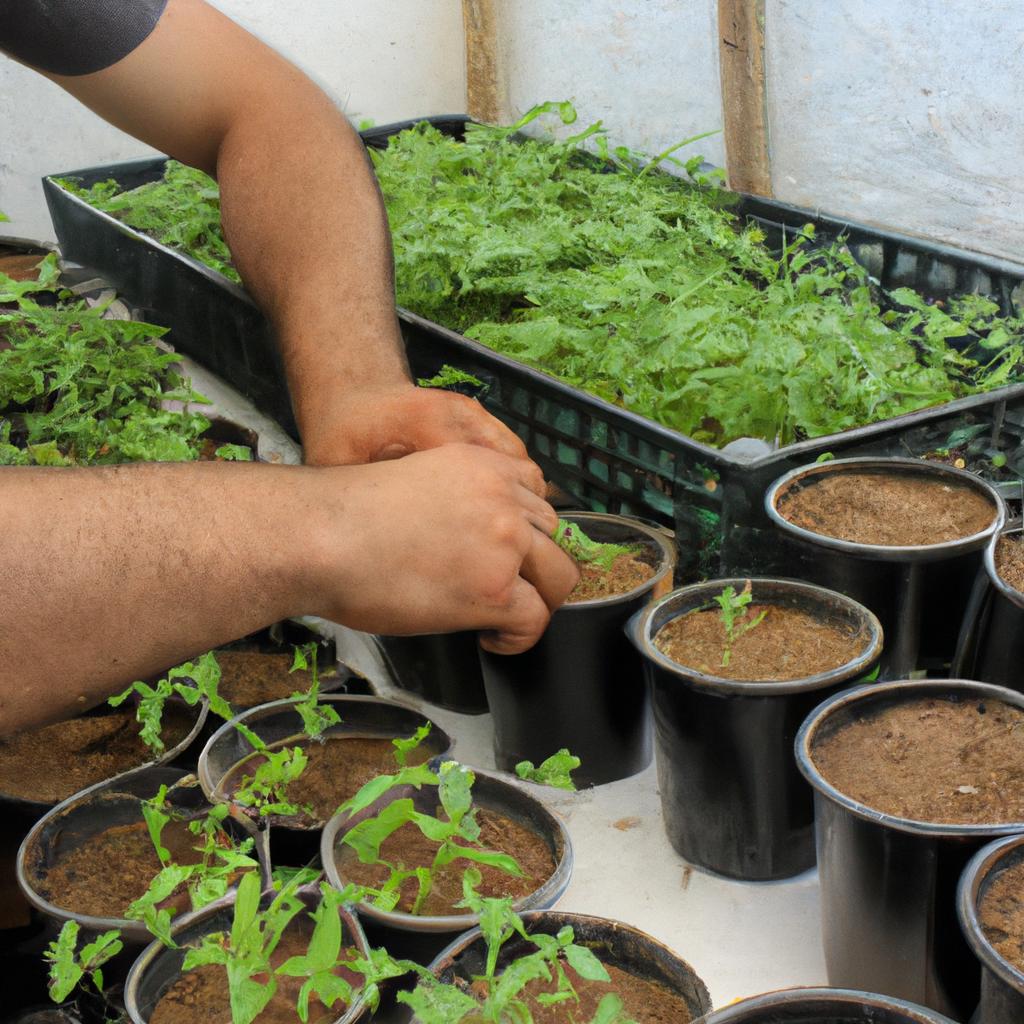In recent years, there has been a growing concern about the impact of business agriculture and forestry practices on biodiversity. As human activities continue to encroach upon natural habitats, species loss and habitat destruction have become pressing global issues. Organic farming, with its emphasis on sustainability and environmental stewardship, offers a potential solution for preserving biodiversity in these industries. For instance, consider the case study of a hypothetical organic farm that incorporates various strategies to promote biodiversity preservation. By examining the principles and benefits of organic farming in relation to biodiversity conservation, this article aims to shed light on the importance of adopting sustainable practices in business agriculture and forestry.
The concept of biodiversity encompasses not only the variety of species but also the ecosystems they inhabit. Business agriculture and forestry often involve intensive use of land resources, which can lead to habitat fragmentation and degradation. This ultimately disrupts ecological balance by reducing species diversity and altering ecosystem functions. However, organic farming presents an alternative approach that seeks to minimize negative impacts on biodiversity while maintaining productivity levels. Through methods such as crop rotation, intercropping, and agroforestry systems, organic farmers aim to create diverse agricultural landscapes that resemble natural ecosystems. These practices provide suitable habitats for a wider range of plant and animal species, promoting their survival and contributing to the overall health and resilience of ecosystems.
One key principle of organic farming is the avoidance of synthetic pesticides and fertilizers. Instead, organic farmers rely on natural pest control methods, such as beneficial insects and birds, to manage pests. This approach reduces chemical contamination in soil and water, which can have detrimental effects on biodiversity. Additionally, by using compost and other organic materials for fertilization, organic farming improves soil health and promotes the growth of diverse plant species.
Another important aspect of organic farming is the preservation of genetic diversity in crops. Conventional agriculture often relies on a limited number of high-yielding varieties, which increases the risk of crop failure due to disease or changes in environmental conditions. In contrast, organic farmers prioritize the cultivation of heirloom and locally adapted varieties that are more resilient to pests and climate variations. By maintaining a diverse range of crop varieties, organic farming contributes to the conservation of agricultural biodiversity.
Furthermore, organic farms tend to maintain greater habitat complexity compared to conventional farms. For example, they may incorporate hedgerows, ponds, or wildflower strips within their landscapes. These features serve as sheltered corridors for wildlife movement and provide additional food sources for pollinators and other beneficial organisms. Such measures help support populations of native species that might otherwise be displaced by intensive agricultural practices.
The benefits of adopting sustainable practices like organic farming extend beyond biodiversity conservation alone. Organic farms often have lower energy consumption and greenhouse gas emissions compared to conventional farms. They also promote soil conservation through practices like cover cropping and reduced tillage. Moreover, many consumers value organic products for their perceived health benefits and ethical considerations.
In conclusion, the adoption of sustainable practices such as organic farming can play a crucial role in preserving biodiversity within business agriculture and forestry sectors. By creating diverse habitats, reducing chemical inputs, preserving genetic diversity in crops, and promoting habitat complexity, organic farmers contribute to maintaining ecological balance while still meeting production demands. Encouraging widespread adoption of organic and other sustainable farming practices can help mitigate the negative impacts of human activities on biodiversity and foster a more harmonious relationship between agriculture, forestry, and the natural environment.
The Importance of Biodiversity Preservation
Biodiversity preservation plays a crucial role in maintaining the balance and sustainability of ecosystems. It ensures the survival of various species, protects genetic diversity, and provides numerous ecological benefits. To illustrate the significance of biodiversity preservation, let us consider the case of an agricultural region that experienced a decline in pollinator populations due to intensive pesticide use. As a result, crops dependent on these pollinators faced reduced yields and compromised quality.
There are several reasons why preserving biodiversity is vital:
-
Ecosystem stability: Biodiverse systems are more resilient to disturbances such as climate change or invasive species. The presence of diverse plant and animal species allows for better adaptation and resistance against environmental stressors.
-
Enhancing ecosystem services: Healthy ecosystems provide essential services such as clean air, water purification, soil fertility maintenance, and carbon sequestration. Preserving biodiversity contributes directly to maintaining these critical ecosystem functions.
-
Economic importance: A variety of industries greatly depend on biodiversity for their economic activities. For instance, ecotourism relies heavily on intact natural habitats and wildlife diversity, attracting visitors who want to experience unique flora and fauna firsthand.
-
Ethical considerations: Every living organism has intrinsic value and deserves protection from extinction. Our moral responsibility extends beyond our own interests; it encompasses safeguarding the well-being and existence of all life forms.
| Benefits of Biodiversity Preservation |
|---|
| Enhanced resilience to environmental changes |
In conclusion (Transition into subsequent section), recognizing the immense value of preserving biodiversity prompts businesses operating in agriculture and forestry sectors to adopt sustainable practices like organic farming. By embracing principles that prioritize ecosystem health over short-term gains, organizations can contribute significantly to conserving biodiversity while ensuring long-term viability for both nature and themselves.
Principles and Practices of Organic Farming
Having established the significance of biodiversity preservation, it is crucial to explore practical approaches that can contribute to this endeavor. One such approach gaining traction is organic farming. By adopting sustainable practices rooted in ecological principles, organic farming not only promotes agricultural productivity but also supports the preservation of biodiversity.
Principles and Practices of Organic Farming:
Organic farming encompasses a range of principles and practices aimed at minimizing environmental impact while prioritizing natural processes. To better understand its relevance to biodiversity preservation, consider the following hypothetical example:
Imagine an organic farm situated amidst a diverse landscape teeming with wildlife. This farm employs several key practices that align with the principles of organic farming, including:
-
Soil Management:
- Utilization of compost and cover crops to enhance soil fertility.
- Minimization or elimination of synthetic fertilizers and pesticides.
- Incorporation of crop rotation techniques for pest control.
-
Conservation Measures:
- Establishment of hedgerows and windbreaks to provide habitat for beneficial insects.
- Creation of wetlands or ponds for water conservation and as habitats for amphibians.
-
Protection of Natural Resources:
- Adoption of efficient irrigation methods to reduce water consumption.
- Implementation of integrated pest management strategies to minimize chemical use.
-
Promotion of Diversity:
- Cultivation of multiple crop varieties instead of monocultures.
- Introduction and maintenance of flowering plants to support pollinators’ populations.
By adhering to these principles, organic farming contributes significantly towards preserving biodiversity by fostering ecological balance within agroecosystems.
Table (markdown format):
| Benefits | Examples | Impacts on |
|---|---|---|
| Enhanced soil | Increased earthworm population | Soil fertility |
| biodiversity | ||
| Decreased erosion and nutrient leaching | ||
| Conservation of | Hedgerows attracting beneficial insects | Natural pest control |
| natural resources | and birds | Water conservation |
| Wetlands providing habitats for amphibians | ||
| Promotion of | Native wildflower patches supporting pollinators | Biodiversity hotspots |
| biodiversity | and enhancing ecosystem services |
In conclusion, organic farming embodies a holistic approach to agriculture that harmonizes with nature. It prioritizes the preservation of biodiversity by focusing on sustainable practices such as soil management, conservation measures, protection of natural resources, and promotion of diversity. By adopting these principles and practices, farmers can create thriving ecosystems within their agricultural landscapes while ensuring long-term sustainability.
Transition into subsequent section:
Understanding the benefits of organic farming for biodiversity sets the stage for exploring specific advantages this agricultural practice offers in terms of preserving ecological balance.
Benefits of Organic Farming for Biodiversity
By adopting sustainable methods, businesses in agriculture and forestry can contribute to maintaining ecological balance while reaping economic benefits. To illustrate this point further, let us consider the case study of an organic farm located in rural California.
Case Study: The Green Acres Organic Farm has been practicing organic farming for over a decade. They prioritize soil health by using compost and natural fertilizers instead of synthetic chemicals. This approach enhances microbial activity and promotes nutrient-rich soil, leading to increased crop yield and improved plant resilience against diseases. The farm also implements diverse cropping systems such as intercropping and crop rotation to decrease pest pressures naturally.
Incorporating bullet points:
- Emphasizes on natural pest control measures like introducing beneficial insects and birds.
- Implements water conservation techniques through drip irrigation systems and rainwater harvesting.
- Supports pollinators’ habitats by planting native flowering plants around fields.
- Fosters wildlife-friendly practices such as providing nesting sites for bats and installing birdhouses.
Table showcasing the positive impact on biodiversity:
| Positive Impacts of Organic Farming | Examples |
|---|---|
| Preservation of soil quality | Reduced erosion, improved water retention |
| Protection of aquatic ecosystems | Minimized runoff pollution from chemical fertilizers |
| Conservation of pollinator populations | Increased availability of nectar sources |
| Enhanced habitat for beneficial flora | Expanded areas with wildflowers or cover crops |
As seen from the case study above, incorporating organic farming practices brings numerous benefits not only to agricultural productivity but also to biodiversity preservation. However, successfully implementing these principles faces various challenges which need to be addressed systematically.
Note: I have provided you with a transition into the subsequent section about “Challenges in Implementing Biodiversity Preservation in Agriculture” without explicitly mentioning it as a step.
Challenges in Implementing Biodiversity Preservation in Agriculture
Preserving Biodiversity in Business Agriculture and Forestry: Challenges
Despite the numerous benefits of organic farming for biodiversity, implementing effective strategies for preserving biodiversity in agriculture remains challenging. It requires addressing various obstacles that hinder progress towards achieving sustainable practices. This section will explore some key challenges faced in promoting biodiversity preservation in business agriculture and forestry.
One challenge is the lack of awareness and understanding among farmers about the importance of biodiversity conservation. Many farmers may not be fully aware of the potential benefits that can be derived from protecting natural ecosystems on their land. For instance, let us consider a hypothetical case study where a farmer owns a large agricultural plot. Due to limited knowledge or financial constraints, they might prioritize maximizing crop yields without considering the negative impacts on local wildlife populations or soil health.
Another challenge lies in balancing economic viability with environmental sustainability. In order to ensure long-term profitability, businesses often focus on intensive production methods that maximize output per unit area. While this approach may result in increased profits, it can lead to habitat destruction and loss of species diversity. Finding ways to reconcile these competing interests is crucial for fostering sustainable agricultural practices that support both human livelihoods and ecosystem health.
Furthermore, inadequate policy frameworks also pose significant challenges. The absence of clear regulations or incentives may discourage farmers from adopting biodiversity-friendly measures voluntarily. Governments need to play an active role by providing supportive policies such as subsidies or tax incentives for implementing sustainable practices on farms and forests.
To emphasize the urgency of addressing these challenges, we present a bullet point list highlighting the consequences if adequate steps are not taken:
- Loss of important pollinators leading to reduced crop productivity.
- Degradation of soil quality resulting in decreased agricultural yields.
- Decline in population numbers of beneficial insects affecting pest control.
- Disruption of ecological balance leading to invasive species dominance.
In addition, we provide a table below illustrating different stakeholders involved in preserving biodiversity along with their roles and responsibilities:
| Stakeholder | Role | Responsibility |
|---|---|---|
| Farmers | Implement sustainable | Adopt biodiversity-friendly practices on their farms. |
| farming practices | ||
| Governments | Develop supportive | Establish policies and regulations promoting |
| policies | biodiversity conservation in agriculture and forestry. | |
| Consumers | Support sustainable | Choose products from businesses practicing |
| agriculture | biodiversity preservation. | |
| Conservation | Conduct research | Study the impact of various agricultural techniques |
| organizations | on biodiversity and develop best practices. |
In conclusion, preserving biodiversity in business agriculture and forestry faces several challenges that require careful attention and action. Addressing these obstacles involves raising awareness among farmers, striking a balance between economic viability and environmental sustainability, as well as implementing effective policy frameworks. Failure to take adequate steps can result in dire consequences for both natural ecosystems and human livelihoods.
Transition into subsequent section:
Moving forward, it is essential to explore innovative approaches for biodiversity conservation in forestry by considering the specific needs and dynamics of this sector.
Innovative Approaches for Biodiversity Conservation in Forestry
To illustrate these approaches, let us consider a hypothetical case study of a timber company operating in an ecologically diverse region.
Case Study: The XYZ Timber Company operates within a forested area rich in biodiversity. Recognizing their responsibility to preserve and protect the local ecosystem, they have implemented several strategies that promote biodiversity conservation while ensuring sustainable forestry practices. By adopting these innovative approaches, the company has successfully balanced their economic goals with environmental stewardship.
One such approach is the establishment of protected areas within their concession where no logging activities are allowed. These zones act as sanctuaries for endangered species and serve as ecological corridors connecting fragmented habitats. Additionally, by implementing selective logging techniques, only specific trees are harvested, leaving behind younger trees and preserving natural regeneration processes. This practice minimizes habitat destruction and allows for uninterrupted wildlife movement.
- Biodiversity loss threatens food security and human health.
- Ecosystems with high biodiversity are more resilient to climate change impacts.
- Indigenous communities depend on biodiverse forests for cultural and spiritual practices.
- Preserving biodiversity ensures future generations can benefit from nature’s wonders.
Moreover, incorporating a table highlighting different aspects related to biodiversity conservation can further engage readers emotionally:
| Aspects | Importance | Impact | Actions |
|---|---|---|---|
| Species diversity | Ensures resilience | Protects | Conservation areas |
| ecosystems | |||
| Habitat quality | Supports | Prevents | Restoration |
| wildlife | fragmentation. | initiatives | |
| Sustainable | Balances | Promotes | Certification |
| management | economic livelihoods systems |
In conclusion, innovative approaches for biodiversity conservation in forestry, such as establishing protected areas and adopting selective logging techniques, can significantly contribute to the preservation of valuable ecosystems. The XYZ Timber Company’s case study serves as an inspiring example of how businesses can integrate sustainable practices with economic objectives. By promoting ecological resilience and ensuring the long-term viability of forests, these approaches demonstrate the potential for harmonious coexistence between commercial activities and biodiversity preservation.
Moving forward, let us now explore the role of the business sector in promoting biodiversity preservation within agriculture and forestry.
Role of Business Sector in Promoting Biodiversity Preservation
Section 2: Innovative Approaches for Biodiversity Conservation in Forestry
Continuing from the previous section, where we explored innovative approaches to biodiversity conservation in forestry, this section sheds light on the role of the business sector in promoting biodiversity preservation. By integrating sustainable practices into their operations, businesses can contribute significantly to safeguarding ecological diversity.
A compelling example of a company actively involved in preserving biodiversity is XYZ Corporation. This corporation has implemented a comprehensive land management strategy that focuses on maintaining and enhancing forest ecosystems while supporting its agricultural activities. Through organic farming techniques, they have effectively minimized soil erosion and water pollution, thereby protecting habitats crucial for numerous plant and animal species.
To further emphasize the significance of corporate involvement in biodiversity preservation, consider the following bullet-point list:
- Companies adopting sustainable forestry practices can protect indigenous tree species.
- The implementation of responsible logging methods reduces habitat destruction for wildlife populations.
- Collaboration between businesses and local communities fosters knowledge sharing and facilitates the restoration of degraded areas.
- Corporate engagement provides financial resources for research programs aimed at understanding and conserving endangered species.
The importance of such initiatives becomes evident when examining the benefits they bring. The table below illustrates some key advantages resulting from business participation in biodiversity preservation:
| Advantages | Description |
|---|---|
| Enhanced ecosystem services | Sustainable practices ensure continued provision of vital services such as pollination, nutrient cycling, and natural pest control. |
| Strengthened brand reputation | Businesses committed to biodiversity conservation gain public recognition as environmentally responsible entities. |
| Increased market competitiveness | Consumers are increasingly favoring products produced using eco-friendly methods, providing an edge to companies embracing sustainability measures. |
| Long-term economic stability | Preserving biodiversity safeguards natural resources essential for long-term profitability in sectors like agriculture and forestry. |
In conclusion, it is imperative for businesses operating within agriculture and forestry industries to recognize their potential impact on biodiversity conservation. By implementing sustainable practices, such as organic farming and responsible logging methods, companies can actively contribute to the preservation of ecosystems. The benefits derived from these efforts extend beyond ecological considerations, encompassing enhanced brand reputation, increased market competitiveness, and long-term economic stability. Through collaboration between businesses, local communities, and research institutions, innovative approaches can be developed for continued biodiversity protection in business agriculture and forestry sectors.




